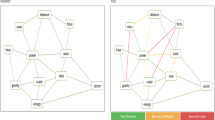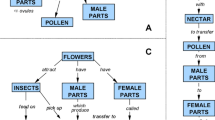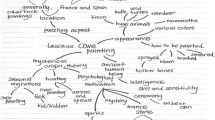Abstract
This investigation applies two approaches for representing and comparing text structures as undirected network graphs to describe the influence of narrative and expository lesson texts on readers’ knowledge structure elicited as free recall. Narrative and expository lesson texts and undergraduate participants’ free recall essays (n = 90) from a study by Wolfe and Mienko (Br J Educ Psychol 77, 541–564, 2007) were reanalyzed for lexical proximity as sequential occurrence of selected important terms in the text and as actual minimum distances between these terms. The proximity data were then rendered as Pathfinder networks for analysis. Compared to human-rater benchmark measures, the convergent validity of the sequential approach (range of r = .53 to .83, median r = .70) was a little better than that of the minimum distance approach (.51 to .80, median r = .67). Further, we anticipated that the lesson text structure would be reflected in the text structure of the free recall essays, but this was not observed. On average, the essays in all three lesson conditions tended to converge on a sequential expository structure. Further, compared to the expository lesson texts, the narrative lesson text had a distinctly different influence on posttest recall essay text structures. Overall then, the sequential occurrence approach appears to provide a reasonably good, automatically derived method for representing and comparing lesson texts and participants’ essays as network graphs. If further confirmed and fully automated, there is a wide range of application of such measurement approaches for learning and research.




Similar content being viewed by others
References
Abbott, H. P. (2002). The Cambridge introduction to narrative. Cambridge, UK: Cambridge University Press.
Berlanga, A. J., van Rosmalen, P., Boshuizen, H. P. A., & Sloep, P. B. (2012). Exploring formative feedback on textual assignments with the help of automatically created visual representations. Journal of Computer Assisted Learning, 28, 146–160.
Bruner, J. (1990). Acts of meaning. Cambridge, MA: Harvard University Press.
Busselle, R., & Bilandzic, H. (2008). Fictionality and perceived realism in experiencing stories: A model of narrative comprehension and engagement. Communication Theory, 18, 255–280.
CCSS. (2010). Common core state standards for English language arts and literacy in history/social studies, science, and technical subjects; Appendix A: Research supporting key elements of the standards. Available from the Council of Chief State School Officers, Washington, DC. Retrieved July 22, 2014, from http://www.corestandards.org/assets/Appendix_A.pdf.
Clariana, R. B. (2004). Analysis of lexical aggregates (ALA-Reader). Retrieved July 22, 2014, from http://www.personal.psu.edu/rbc4/score.htm.
Clariana, R. B. (2010). Deriving group knowledge structure from semantic maps and from essays. In D. Ifenthaler, P. Pirnay-Dummer, & N. M. Seel (Eds.), Computer-based diagnostics and systematic analysis of knowledge (pp. 117–130). New York, NY: Springer.
Clariana, R. B., & Koul, R. (2004). A computer-based approach for translating text into concept map-like representations. In A. J. Canas, J. D. Novak, & F. M. Gonzales (Eds.), Concept maps: Theory, methodology, technology (Vol. 2). In Proceedings of the first international conference on concept mapping, Pamplona, Spain, Sep. 14–17, pp. 131–134.
Clariana, R. B., & Prestera, G. E. (2009). The effects of lesson screen background color on declarative and structural knowledge. Journal of Educational Computing Research, 40, 281–293.
Clariana, R. B., & Taricani, E. M. (2010). The consequences of increasing the number of terms used to score open-ended concept maps. International Journal of Instructional Media, 37, 163–173.
Clariana, R. B., & Wallace, P. E. (2007). A computer-based approach for deriving and measuring individual and team knowledge structure from essay questions. Journal of Educational Computing Research, 37, 209–225.
Clariana, R. B., Wallace, P. E., & Godshalk, V. M. (2009). Deriving and measuring group knowledge structure from essays: The effects of anaphoric reference. Educational Technology Research and Development, 57, 725–737.
Cunningham, L. J., & Gall, M. D. (1990). The effects of expository and narrative prose on student achievement and attitudes toward textbooks. Journal of Experimental Education, 58, 165–175.
Draper, D. (2010). The instructional effects of knowledge-based community of practice learning environments on student achievement and knowledge convergence. Doctoral dissertation retrieved July 22, 2014, from https://etda.libraries.psu.edu/paper/10629/.
Dubeck, L. W., Bruce, M. H., Schmuckler, J. S., Moshier, S. E., & Boss, J. E. (1990). Science fiction aids science teaching. The Physics Teacher, 28, 316–318.
Goldsmith, T. E., Johnson, P. J., & Acton, W. H. (1991). Assessing structural knowledge. Journal of Educational Psychology, 83, 88–96.
Ifenthaler, D. (2010). Relational, structural, and semantic analysis of graphical representations and concept maps. Educational Technology Research and Development, 58, 81–97. doi:10.1007/s11423-008-9087-4.
Jonassen, D. H., & Hernandez-Serrano, J. (2002). Case-based reasoning and instructional design: Using stories to support problem-solving. Educational Technology Research and Development, 50(2), 65–77.
Kim, M. K. (2012). Cross-validation study of methods and technologies to assess mental models in a complex problem solving situation. Computers in Human Behavior, 28, 703–717.
Kintsch, W. (1977). On comprehending stories. In M. A. Just & P. A. Carpenter (Eds.), Cognitive processes in comprehension (pp. 33–62). Hillsdale, NJ: Erlbaum.
Klois, S. S., Segers, E., Clariana, R. B., & Verhoeven, L. (2013). Effects of links in children’s digital text comprehension. A presentation with paper at the Twentieth Annual Meeting Society for the Scientific Study of Reading, Hong Kong (July).
Koul, R., Clariana, R. B., & Salehi, R. (2005). Comparing several human and computer-based methods for scoring concept maps and essays. Journal of Educational Computing Research, 32, 261–273.
Lave, J., & Wenger, E. (1991). Situated learning, legitimate peripheral participation. New York, NY: Cambridge University Press.
Meyer, B. J. F., Brandt, D. M., & Bluth, G. J. (1980). Use of top-level structure in text: Key for reading comprehension of ninth-grade students. Reading Research Quarterly, 16, 72–103.
Meyer, B. J. F., Young, C. J., & Bartlett, B. J. (1989). Memory improved: Reading and memory enhancement across the life span through strategic text structures. Hillsdale, NJ: Lawrence Erlbaum Associates.
Moss, B., & Newton, E. (2002). An examination of the informational text genre in basal readers. Reading Psychology, 23, 1–13.
Roller, C. M., & Schreiner, R. (1985). The effects of narrative and expository organizational instruction on sixth-grade children’s comprehension of expository and narrative prose. Reading Psychology: An International Quarterly, 6, 27–42.
Sáenz, L. M., & Fuchs, L. S. (2002). Examining the reading difficulty of secondary students with learning disabilities: Expository versus narrative text. Remedial and Special Education, 23, 31–41.
Schneider, W., Körkel, J., & Weinert, F. E. (1989). Domain-specific knowledge and memory performance: A comparison of high- and low-aptitude children. Journal of Educational Psychology, 81, 306–312.
Schvaneveldt, R. W. (Ed.). (1990). Pathfinder associative networks: Studies in knowledge organization. Norwood, NJ: Ablex.
Segal, E. M. (1995a). Narrative comprehension and the role of deictic shift theory. In J. F. Duchan, G. A. Bruder, & L. E. Hewitt (Eds.), Deixis in narrative: A cognitive science perspective (pp. 3–17). Hillsdale, NJ: Lawrence Erlbaum Associates.
Segal, E. M. (1995b). A cognitive-phenomenological theory of fictional narrative. In J. F. Duchan, G. A. Bruder, & L. E. Hewitt (Eds.), Deixis in narrative: A cognitive science perspective (pp. 61–78). Hillsdale, NJ: Lawrence Erlbaum Associates.
Spilich, G. J., Vesonder, G. T., Chiesi, H. L., & Voss, J. F. (1979). Text processing of domain-related information for individuals with high and low domain knowledge. Journal of Verbal Learning and Verbal Behavior, 18, 275–290.
Storey, D. C. (1982). Reading in the content areas: Fictionalized biographies and diaries for social studies. The Reading Teacher, 35, 796–798.
Trabasso, T., & van den Broek, P. (1985). Causal thinking and the representation of narrative events. Journal of Memory and Language, 24, 612–630.
van Dijk, T. A., & Kintsch, W. (1983). Strategies of discourse comprehension. New York, NY: Academic Press.
Wolfe, M. B. (2005). Memory for narrative and expository text: Independent influences of semantic associations and text organization. Journal of Experimental Psychology: Learning, Memory, and Cognition, 31, 359–364.
Wolfe, M. B., & Mienko, J. A. (2007). Learning and memory of factual content from narrative and expository text. British Journal of Educational Psychology, 77, 541–564.
Zabrucky, K. M., & Moore, D. (1999). Influence of text genre on adults’ monitoring of understanding and recall. Educational Gerontology, 25, 691–710.
Zwaan, R. A., & Radvansky, G. A. (1998). Situation models in language comprehension and memory. Psychological Bulletin, 123, 162–185.
Author information
Authors and Affiliations
Corresponding author
Rights and permissions
About this article
Cite this article
Clariana, R.B., Wolfe, M.B. & Kim, K. The influence of narrative and expository lesson text structures on knowledge structures: alternate measures of knowledge structure. Education Tech Research Dev 62, 601–616 (2014). https://doi.org/10.1007/s11423-014-9348-3
Published:
Issue Date:
DOI: https://doi.org/10.1007/s11423-014-9348-3




